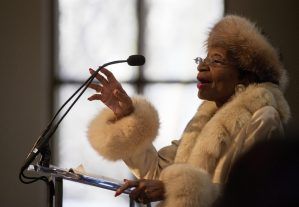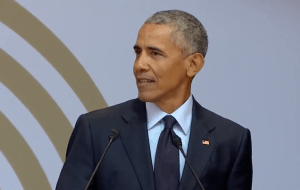Planning A Fireworks Display? Here’s How To Stay Safe So You Don’t End Up In Harlem Hospital
The #1 source in the world for all things Harlem.
Fourth of July usually means big-time sales and trips to get away for a long weekend. And for many Harlemites, it also means fireworks. While fireworks are fun and provide great entertainment on warm summer nights, they also come with a great deal of injury risk. According to the Consumer Product Safety Commission’s 2022 Fireworks Annual Report, there were 11…
The post Planning A Fireworks Display? Here’s How To Stay Safe So You Don’t End Up In Harlem Hospital appeared first on Harlem World Magazine.
Affirmative action is out in higher education. What comes next for college admissions?

Colleges across the country will be forced to stop considering race in admissions under Thursday’s Supreme Court ruling, ending affirmative action policies that date back decades.
Schools that have relied on race-conscious admissions policies to build diversity will have to rethink how they admit students. It’s expected to result in campuses that have more white and Asian American students and fewer Black and Hispanic students.
The impact of the decision will be felt most strongly at the nation’s most selective colleges, which have been more likely to consider race as one of many factors in admissions. But some less selective universities also consider race, and hundreds of colleges may need to adjust their admissions systems in response to the decision.
Colleges say they’re still analyzing the decision, but it’s sure to have a dramatic impact nationwide. Here’s what we know so far.WHEN WILL THE RULING TAKE EFFECT?
Today’s incoming high school seniors will be the first to see any change. Many of them will be applying for college over the next year as colleges remove race from admissions decisions. The process probably won’t look much different for students — maybe there will be another question or two about their life experiences — but behind the scenes, there could be big changes in the way colleges evaluate applications.
At Northeastern University, President Joseph E. Aoun said in a campus message the decision “will dramatically alter the use of race as a factor in college admissions.”HOW MANY COLLEGES CONSIDER RACE?
No one knows for sure. Colleges aren’t required to disclose whether they consider race, and the federal government doesn’t track it. A survey of about 200 colleges in 2019 found that roughly four in 10 colleges said race had at least limited influence in admissions decisions. The practice is most common at highly selective institutions, while many less selective schools don’t consider race.
Nine states have separately banned affirmative action at private universities, including California, Michigan, Florida and Washington.
In states that already banned affirmative action, colleges responded by recruiting more low-income students, hoping that wealth would act as a proxy for race. Some colleges also started “percentage” plans that offer admission to top students at every high school in their state. Such approaches have had mixed results. But expect to see more colleges trying alternate approaches.HOW ARE COLLEGES GOING TO CHANGE ADMISSIONS?
An alternate approach floated by some would put greater emphasis on students who overcome adversity. President Joe Biden endorsed that approach Thursday, saying adversity should be a “new standard” in college admissions, rewarding those who overcome challenges related to income, race or other factors.
The court’s decision appears to allow such an approach. The conservative majority wrote that “nothing prohibits universities from considering an applicant’s discussion of how race affected the applicant’s life,” as long as it’s tied to a particular quality the applicant brings to campus.
Applicants may see more colleges add questions about adversity or other life experiences. But the decision also warns about going too far, saying colleges can’t simply use essays to revive “the regime we hold unlawful today.”
What’s clear is that any direct consideration of race in admission decisions will have to end, meaning colleges will no longer be able to give an edge to underrepresented minorities simply because of their race.WHAT DOES THIS MEAN FOR LEGACY ADMISSIONS?
With affirmative action off the table, colleges face mounting pressure to end other admission practices that disproportionately benefit white and wealthy students. Chief among those are legacy preferences, the practice of giving an admission boost to the children of alumni.
Within hours of the decision, activists and some Democrats in Congress were urging colleges to abandon the policy. Biden took a shot at it too, saying he’s asking the Education Department to examine legacy preferences and other practices that “expand privilege instead of opportunity.” A small but notable group of colleges have dropped the practice in recent years, including Johns Hopkins University and Amherst College, but it continues at many others, including Harvard and other Ivy League schools.
Activists are also taking aim at other policies seen as barriers for underrepresented students, including donor preferences and standardized tests like the SAT and ACT. Hundreds of colleges made entrance exams optional during the pandemic, and there’s a growing push to make the change permanent.WHAT ARE COLLEGES SAYING?
Colleges across the country said they’re committed to campus diversity no matter what the court says. Campus leaders say they’re still sorting how the decision will affect them, but many expressed optimism that they will legally find other ways to bring a diverse mix of students to campus.
In Texas, Rice University’s president said he’s “greatly disappointed” but also “more resolute than ever” to pursue diversity. “The law may change, but Rice’s commitment to diversity will not,” President Reginald DesRoches said. At Union College in New York, President David Harris said students of color will continue to feel welcome — “but make no mistake this Supreme Court decision will make our work more challenging,” he said.
Colleges are sending a welcoming message in hopes of avoiding the type of drop-off among Black and Hispanic students that have been seen in some states that outlawed affirmative action.WHY WERE COLLEGES C
ONSIDERING RACE IN THE FIRST PLACE?
In several decisions dating to the 1970s, the Supreme Court had upheld affirmative action in college admissions. Past rulings found that colleges have a compelling interest in promoting racial diversity because of the benefits it provides. They say it exposes students to differing viewpoints and helps prepare future leaders, among other benefits. Colleges say race has been a small factor, sometimes giving an edge to underrepresented students. Opponents dispute that notion, citing research finding a boost for Black applicants equivalent to 310 points on the SAT exam.
Thursday’s decision reversed course on the earlier decisions. The court found that while the benefits cited by universities are “commendable,” they don’t pass legal muster because they aren’t concrete enough to be measured and they don’t have a clear end goal. “The universities’ main response to these criticisms is, essentially, ‘trust us,’” the court wrote.
___
The Associated Press education team receives support from the Carnegie Corporation of New York. The AP is solely responsible for all content.
The post Affirmative action is out in higher education. What comes next for college admissions? appeared first on New York Amsterdam News.
Update for Friday June 30, 2023 – Wise County Messenger
Update for Friday June 30, 2023 Wise County Messenger
Christine King Farris, the last living sibling of Martin Luther King Jr., dies at 95

ATLANTA (AP) — Christine King Farris, the last living sibling of the Rev. Martin Luther King Jr., has died.
Her niece, the Rev. Bernice King, tweeted that her “beloved aunt” died Thursday. She was 95.
For decades after her brother’s assassination in 1968, Farris worked along with his widow, Coretta Scott King, to preserve and promote his legacy. But unlike her high-profile sister-in-law, Farris’ activism — and grief — was often behind the scenes.
“She may not have always been on the line of the march, but that was true with a lot of the heroes of the Civil Rights Movement,” said Marcellus Barksdale, a history professor at Morehouse College, of Farris in a 2009 interview with The Associated Press. “Because of the luminescence of Dr. King and Coretta Scott King, Christine kind of got dimmed by that, but she was no less important.”
Farris was born Willie Christine King on Sept. 11, 1927, in Atlanta. She was the first child of the Rev. Martin Luther King Sr. and Alberta Christine Williams King.
Farris helped Coretta Scott King build The King Center and helped to teach Martin Luther King Jr.’s philosophy of nonviolent resistance. For years, her regal, dignified presence was a mainstay at the ecumenical service celebrating her brother’s birthday at Ebenezer Baptist Church, where her grandfather and father also preached and where Farris remained a member.
The King Center tweeted Thursday that it mourns the loss of Farris, a founding board member, former vice-chair and treasurer, along with a photo of her.
Bernice King tweeted a photo of herself with Farris, writing, “I love you and will miss you, Aunt Christine.”
Martin Luther King III tweeted that he, his wife and his daughter had been able to spend time with his aunt in her final days.
“Aunt Christine embodied what it meant to be a public servant. Like my dad, she spent her life fighting for equality and against racism in America,” he tweeted. “She defied the odds that held back too many marginalized communities – going on to become a civil rights leader and acclaimed author. No stranger to adversity, Aunt Christine used the tragedies of the assassinations of her mother and brother to fight for change in America.”
Farris outlived many of the people she loved, including her parents, her two brothers, her sister-in-law and her niece, Yolanda. She graduated from Spelman College in 1948 with a degree in economics on the same day Martin Luther King Jr. earned his degree in sociology from Morehouse College.
A decade later, Farris returned to Spelman, where she worked for more than 50 years. In 1960, she married Isaac Newton Farris. The couple had two children, Angela Christine Farris Watkins and Isaac Newton Farris Jr.
“Our hearts are heavy in Atlanta today, with the news that Christine King Farris has died,” Mayor Andre Dickens said in a statement.
“Mrs. Farris was a force in her own right,” Dickens said. “A champion of literacy and education, she taught at her alma mater, Spelman College, for nearly 50 years. As the last of the King siblings, she spent much of her life advocating for equality. She once said that her brother Martin simply gave us the blueprint, but it was our duty ‘to carry it out.’”
Farris wrote two children’s books about her life, “My Brother Martin: A Sister Remembers Growing Up With the Rev. Dr. Martin Luther King Jr.” and “March On! The Day My Brother Martin Changed the World.” In 2009, she wrote a memoir, “Through It All: Reflections on My Life, My Family and My Faith.”
Farris often shared stories about her brother as a normal child and young man to make him and his achievements more accessible to people.
“They think he simply happened, that he appeared fully formed, without context, ready to change the world,” she said.
The post Christine King Farris, the last living sibling of Martin Luther King Jr., dies at 95 appeared first on New York Amsterdam News.
Man wanted on Jan. 6 charges arrested with weapons near Barack Obama’s Washington home

WASHINGTON (AP) — A man armed with explosive materials and weapons, and wanted for crimes related to the Jan. 6, 2021, insurrection at the U.S. Capitol, was arrested Thursday in the Washington neighborhood where former President Barack Obama lives, law enforcement officials said.
Taylor Taranto, 37, was spotted by law enforcement a few blocks from the former president’s home and fled, though he was chased by U.S. Secret Service agents. Taranto has an open warrant on charges related to the insurrection, two law enforcement officials said. The officials were not authorized to speak publicly about an ongoing case and spoke to The Associated Press on condition of anonymity.
They said Taranto also had made social media threats against a public figure. He was found with weapons and materials to create an explosive device, though one had not been built, one of the officials said.
No one was injured. It was not clear whether the Obamas were at their home at the time of his arrest.
Metropolitan Police arrested Taranto on charges of being a fugitive from justice. The explosives team swept Taranto’s van and said there were no threats to the public.
Taranto was a U.S. Navy veteran and a webmaster for the Republican Party in Franklin County, in Washington state, according to the Tri-City Herald newspaper. He told the newspaper in an interview last year that he was volunteering for the Republican Party.
It wasn’t clear what, exactly, Taranto is accused of doing in the riot, where supporters of then-President Donald Trump smashed windows of the Capitol and beat and bloodied police officers in an effort to overturn the results of the 2020 presidential election.
More than 1,000 people have been charged with federal crimes related to the Capitol riot. Over 600 of them have pleaded guilty, while approximately 100 others have been convicted after trials decided by judges or juries. More than 550 riot defendants have been sentenced, with over half receiving terms of imprisonment ranging from six days to 18 years.
The post Man wanted on Jan. 6 charges arrested with weapons near Barack Obama’s Washington home appeared first on New York Amsterdam News.


